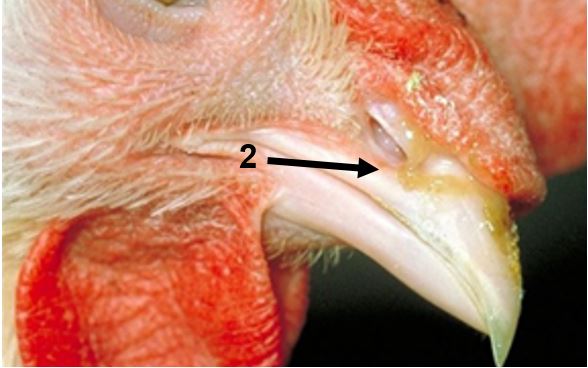
Poultry Diseases: Infectious Coryza
DOWNLOADMay 16, 2019 - Zac Williams and Mick Fulton
Background
While “coryza” has traditionally referred to any respiratory disease of poultry, infectious coryza is a specific bacterial infection caused by the bacteria, Avibacterium paragallinarum. Other common names for infectious coryza include roup or contagious catarrh. Infectious coryza causes poor growth in young birds and a significant (10 to 40 percent) drop in egg laying.
Infectious coryza can occur in birds of any age and mature birds are generally more at risk. The disease is often seen during a flock’s peak egg laying phase. Cases can also occur following stressful events, like birds being relocated. The bacteria that causes infectious coryza is common in certain parts of the country, such as the Southwest, but can appear anywhere that chickens are raised.
Symptoms
The most distinguishing symptoms of infectious coryza are swelling of the face (as seen in image 1) and nasal and eye discharge, as seen in image 2 (photos courtesy of American Association of Avian Pathologists). Additionally, common respiratory signs like coughing and sneezing may be present and the wattles may be swollen (especially in male chickens). Coryza does not usually result in death but will cause a serious drop in egg laying and feed and water consumption may decrease.
Transmission
Birds can be carriers of the disease and still appear healthy, which makes infectious coryza very hard to control, especially on farms without an “all-in, all-out” flock practice. The disease can be spread directly from chicken to chicken and indirectly through aerosol or contaminated feed, water, equipment, and clothing.
Diagnosis and Treatment
Infectious coryza can be diagnosed through lab testing and treated with antibiotics administered through either feed or water.
Control
Several vaccines are available to help prevent coryza, however, they can cause production losses and mortality. Vaccination is usually only used in areas where the disease is commonly found or when an outbreak occurs. The management practice, in areas where this is common, is to remove the affected flock, clean and disinfect the premises, and not repopulate the flock until three weeks after disinfection. As with all diseases, the best prevention is practicing good biosecurity.
Contacts
Dr. Zac Williams
Poultry Extension Specialist
MSU Extension
Will3343@msu.edu
517-355-3855
Dr. Mick Fulton
Poultry Extension Veterinarian
MSU Veterinary Diagnostic Laboratory
fultonr@msu.edu
517-353-3701



 Print
Print Email
Email

